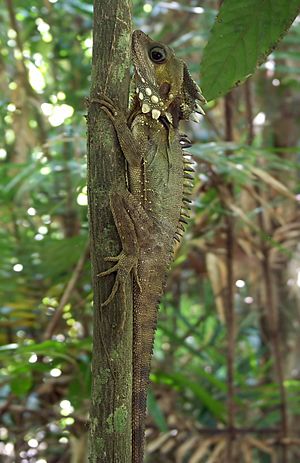Boyd's forest dragon facts for kids
Quick facts for kids Boyd's forest dragon |
|
|---|---|
 |
|
| A Boyd's forest dragon in the Daintree National Park | |
| Scientific classification | |
| Genus: |
Lophosaurus
|
| Species: |
boydii
|
| Synonyms | |
|
|
The Boyd's forest dragon (Lophosaurus boydii) is a cool type of lizard. It lives mostly in trees, which means it's an arboreal animal. You can find these lizards in the rainforests of northern Queensland, Australia. They are part of a group of lizards called agamids.
This dragon is the larger of the two Lophosaurus species found in Australia. Its cousin, the southern angle-headed dragon, lives in southern Queensland and northern New South Wales.
Contents
What's in a Name?
The name Lophosaurus is a mix of two Greek words. Lophos means "crest" and saurus means "lizard". So, Lophosaurus means "crested lizard". This makes sense because they have cool crests!
The second part of its name, boydii, honors a man named John Archibald Boyd. He was from England and lived in Fiji and later in Queensland, Australia. John Boyd collected many animal specimens, including this lizard, for the Australian Museum.
The person who first described this species in 1884 was William John Macleay.
Where Do They Live?
Boyd's forest dragons live only in the rainforests of northern Queensland, Australia. You can find them from just north of Townsville up to Cooktown.
They live in both high and low parts of the rainforest. You might spot them around places like Lake Eacham and Lake Barrine. They also hang out in Malanda Falls Conservation Park and at Mossman Gorge. These lizards sometimes use hollows inside trees as their homes.
What Do They Look Like?
Boyd's forest dragons are usually brown or grey. Some even have a green tint! Their bodies are quite flat from side to side.
They have big scales on their cheeks and a clear crest on their neck. Under their chin, they have a yellow flap of skin called a dewlap. This dewlap has spiky edges. They also have a large eardrum that you can easily see. A spiky crest made of hard scales runs down their back to the base of their tail.
Males and females look a bit different when they are grown up. This is called Sexual dimorphism. Males are bigger than females and have larger, blockier heads.
- Adult males are about 160 millimeters (6.3 inches) long from snout to vent. Their tail adds another 325 mm (12.8 in).
- Adult females are about 140 mm (5.5 in) long from snout to vent. Their tail adds about 280 mm (11 in).
- Males weigh around 150 grams (5.3 ounces).
- Females weigh about 100 grams (3.5 ounces).
How Do They Behave?
Boyd's forest dragons spend most of their time sitting on tree trunks. They usually perch at about head height. If you get too close, they will often move around the tree. They try to keep the tree trunk between you and them.
Unlike many other lizards, these dragons don't sunbathe. They let their body temperature change with the air temperature. However, pregnant females might be an exception. They are sometimes seen sitting on or near forest roads, and their body temperature is higher.
These dragons are active from dawn until dusk. They even stay active when it rains! But their activity changes with the seasons. During cooler months, they become much less active. They usually move higher into the rainforest canopy then.
Both male and female dragons seem to defend their own areas. Males protect a larger space, about 1,000 square meters (0.247 acres). A male's territory often includes the territories of several females.
At night, young dragons and smaller adults often "sleep" at the ends of tree branches. They point their heads back towards the tree trunk.
What Do They Eat?
Boyd's forest dragons are "sit-and-wait" predators. They watch for prey from their perches. Once they spot something, they might move to the ground to catch it. They often keep moving and catching more prey as they go.
Their diet is mostly made up of invertebrates, like insects. Earthworms are a big part of what they eat. Sometimes, they also munch on small fruits or even tiny vertebrates.
How Do They Reproduce?
Boyd's forest dragons lay eggs. A group of eggs is called a clutch. They can lay anywhere from one to six eggs at a time.
Their eggs are about 30 mm (1.2 in) long and 15 mm (0.6 in) wide. Each egg weighs about 3 to 4.5 grams (0.11 to 0.16 oz). Dragons living in higher areas lay bigger and heavier eggs. Females in lower areas might lay more than one clutch in a season. However, these clutches usually have fewer eggs.
The eggs are laid in shallow nests. These nests are often in clearings in the rainforest. Roadsides are also popular spots for nests. The eggs take about 100 days to hatch.
Dragons in lower areas become old enough to have babies in about one to two years. For dragons in higher areas, it probably takes at least a year longer.
Who Are Their Predators?
Young and adult forest dragons can be hunted by grey goshawks and feral pigs. Even their eggs are not safe! Slaty-grey snakes (Stegonotus cucullatus) are known to eat forest dragon eggs.
What About Parasites?
You might sometimes see small orange mites on these dragons. They are often found on the dewlap under their chin and in the groin areas of their legs.

